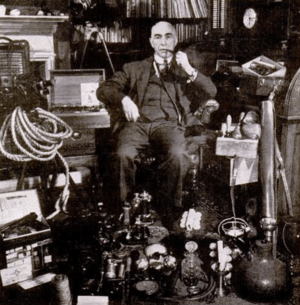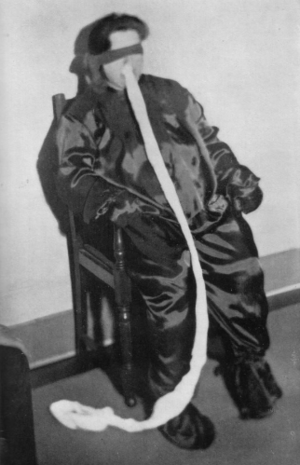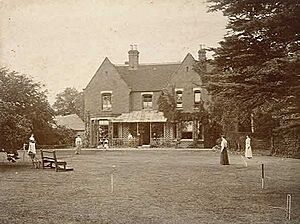Harry Price facts for kids
Quick facts for kids
Harry Price
|
|
|---|---|

A photograph of Harry Price, taken by paranormal hoaxer William Hope in 1922
|
|
| Born | 17 January 1881 London, UK
|
| Died | 29 March 1948 (aged 67) |
| Occupation | Psychic researcher |
| Organization | Magic Circle National Laboratory of Psychical Research American Society for Psychical Research University of London Council for Psychical Investigation The Ghost Club |
Harry Price (born January 17, 1881 – died March 29, 1948) was a British investigator of strange events and an author. He became well-known for looking into mysterious happenings and showing how some people who claimed to have special powers were actually faking it. He is most famous for his investigation of Borley Rectory in Essex, England, which was said to be very haunted.
Contents
Harry Price's Early Life
Harry Price was born in London. When he was 15, he started a drama club and even wrote plays. One of his plays was about a poltergeist (a noisy ghost) he claimed to have met in a haunted house.
Price also had a big interest in collecting coins and wrote articles about them. He once claimed to have experimented with "space-telegraphy" (like an early form of radio), but it was later found that he had only written a press release about it, and it wasn't proven to be true.
Later, Price became interested in archaeology, which is the study of old things. He claimed to find ancient items, but some of these were later found to be fakes. For example, a "silver" bar he found was actually made of cheaper metals and looked like a fake copy of a real Roman artifact. This showed his early interest in uncovering fakes, even if he was involved in some himself.
Magic and Investigating Tricks
Harry Price said that seeing a magician perform when he was young made him want to learn about magic. He became a skilled amateur magician and joined The Magic Circle in 1922. His knowledge of magic tricks and how to do them secretly helped him a lot in his main passion: investigating strange and unexplained events.
Price and another researcher, Eric Dingwall, republished a book called Revelations of a Spirit Medium in 1922. This book was written by someone who used to pretend to have special powers. It showed how "spirit hands" and other ghostly effects were actually just clever tricks. Many copies of this book had been bought by people who believed in spirits and then destroyed, because it revealed their secrets.
Harry Price's Psychic Investigations
In 1920, Price joined the Society for Psychical Research (SPR), a group that studied strange events. Because he knew so much about magic, he was good at spotting fake mediums (people who claimed to talk to spirits). Unlike some other magicians, Price believed that a few mediums might be real.
One of Price's first big successes was in 1922 when he showed that a "spirit" photographer named William Hope was a fraud. In the same year, he traveled to Germany to investigate a medium named Willi Schneider. In 1923, Price exposed another medium, Jan Guzyk, saying he was very clever with his feet to make things happen.
Price also looked into the claims of a medium named Eva Carrière. He thought her "ectoplasm" (a substance supposedly produced by spirits) looked fake, like it was made from cardboard and newspaper. Later, tests showed her ectoplasm was made of chewed paper. In 1925, Price caught Maria Silbert using her feet and toes to move objects during a séance. He also found that a medium named George Valiantine was using an Italian phrasebook to pretend a spirit was speaking Italian.
In 1925, Price started his own group called the National Laboratory of Psychical Research. He had some disagreements with the SPR, especially about whether to pay mediums for tests. Price believed it was important to pay them to get them to agree to strict scientific tests.
Price later offered to give his equipment and library to the University of London to help them study strange events. In 1934, his National Laboratory became the University of London Council for Psychical Investigation. Price also joined the Ghost Club in 1927, a group that discussed paranormal topics.
In 1927, Price claimed to have found a mysterious box belonging to a prophetess named Joanna Southcott. When it was opened, it only contained a few random items, not the important prophecies people expected. This claim has been debated by historians. Price also exposed Frederick Tansley Munnings, who claimed to make the voices of famous historical figures appear. Price used a special voice recorder and proved that all the voices were Munnings's own. In 1928, Munnings admitted he was faking it.
Price was friends with other people who exposed fake mediums, like the famous magician Harry Houdini.
In 1933, Price investigated Frank Decker under very strict scientific conditions. Decker couldn't produce any strange events at all. Price also investigated the Indian rope trick and people who could walk on fire in 1935.
In 1936, Price broadcast from a supposedly haunted house for the BBC. He also published books like The Confessions of a Ghost-Hunter. In 1937, he rented Borley Rectory for a year to investigate it. The next year, he restarted the Ghost Club, making it a group for open-minded skeptics (people who question things) and was the first to let women join.
Famous Investigations by Harry Price
William Hope
On February 4, 1922, Harry Price and other researchers proved that the "spirit" photographer William Hope was a fraud. Price secretly marked Hope's photographic plates and gave him extra plates that had a hidden logo. Hope tried to take "spirit" photos, but none of his pictures showed Price's marks or the hidden logo. This proved that Hope had swapped the plates with his own fake ones.
After Price exposed Hope, Arthur Conan Doyle, the author of Sherlock Holmes, and many other people who believed in spirits were very angry. They thought Price was against spiritualism and tried to stop him from sharing his findings. Price wrote that Doyle and his friends "abused me for years for exposing Hope."
Eileen Garrett
In 1930, after a big airship disaster (the R101), a medium named Eileen J. Garrett claimed to contact the spirit of one of the victims. She talked about what might have caused the accident. Harry Price was there and wrote down everything she said. He didn't say for sure if it was a real spirit or if the information came from her own mind.
However, later investigations suggested that Garrett might have known details about the R101 from news reports or even from someone who worked on the airship. One researcher, Melvin Harris, said that the information Garrett shared was either common knowledge or just confusing talk.
Rudi Schneider
In the 1920s and early 1930s, Price investigated the medium Rudi Schneider, who claimed he could make objects float. Price took a photograph in 1932 that seemed to show Schneider had freed his arm to move a handkerchief. After this, many scientists thought Schneider was a fraud.
Some members of the SPR disagreed with Price and thought he had faked the photograph to make Schneider look bad. But a photography expert said the picture was real. Another SPR member, John L. Randall, also looked at the case and agreed that the photograph was genuine and that Price had caught Schneider cheating.
Helen Duncan
In 1931, Harry Price investigated the medium Helen Duncan. She was suspected of swallowing cheesecloth and then bringing it back up as "ectoplasm" (a ghostly substance). Price proved that a sample of her ectoplasm was indeed cheesecloth. When Price tried to X-ray her, Duncan ran out of the lab, causing a scene. Price believed she gave her fake ectoplasm to her husband to hide.
In another test, Duncan's ectoplasm was found to be made from egg white. Price wrote that it was silly for grown-up men to waste time on "the antics of a fat female crook." After Price's report, Duncan's former maid said she had helped Duncan with her tricks. Duncan's husband also admitted that the ectoplasm was faked by bringing things up from her throat. Duncan was later caught cheating again and was even jailed for nine months in 1944. Price gave his findings as evidence in her trial.
Brocken Experiment
In 1932, Price went to Mount Brocken in Germany to do a "black magic" experiment. He tried to turn a goat into a young man, but it didn't work! Price said he did the experiment "only to prove the fallacy of transcendental magic," meaning he wanted to show that such magic wasn't real.
Gef the Talking Mongoose
In 1935, Price and his friend Richard Lambert investigated the strange case of Gef the talking mongoose on the Isle of Man. They wrote a book about it, but they didn't say they believed the story. They sent a hair supposedly from Gef to a scientist, who said it was actually a dog's hair. Price thought it belonged to the family's sheepdog.
Price also looked at paw prints supposedly made by Gef. An expert couldn't match them to any known animal, and said they were definitely not from a mongoose. Price noticed that the old farmhouse where Gef supposedly lived had double walls with space inside, which could make voices travel easily. Price and Lambert concluded that only very trusting people would believe the story of Gef.
Borley Rectory
Price is most famous for his investigation of Borley Rectory in Essex. He called it "the most haunted house in England" after writing a book about it in 1940. He lived in the rectory from 1937 to 1938 and wrote about his experiences.
After Price died in 1948, some members of the Society for Psychical Research (SPR) investigated his claims about Borley. Their book, The Haunting of Borley Rectory (1956), said that Price had faked some of the strange events. They concluded that many of the supposed hauntings were either faked or caused by natural things like rats or the house's strange sounds.
Some researchers, like Robert Hastings, defended Price. However, others like Michael Coleman said that Price's defenders couldn't strongly argue against the claims of fraud. Price's investigation of Borley Rectory has been the subject of books and TV shows.
Rosalie
In 1937, Price claimed to have attended a private séance where a six-year-old girl named Rosalie appeared. Price said he prepared the room carefully, putting powder on the floor and sealing the windows. He claimed the girl emerged, spoke, and he even took her pulse. After the séance, the powder and seals were untouched, making him believe no one had entered.
However, some researchers like Eric Dingwall and Trevor Hall later said the Rosalie séance was made up by Price. But K. M. Goldney, who had criticized Price before, said Price was "shaken to the core" by the experience and believed he was telling the truth. In 1985, a letter was published from someone who claimed to have pretended to be Rosalie at the séance, saying the father had asked them to do it.
Death and Legacy
Harry Price died from a heart attack at his home in West Sussex on March 29, 1948.
His collection of papers, letters, and investigation reports were given to the University of London by his wife. His large collection of magic books and magazines, which has 13,000 items, is also kept at the Senate House Library at the University of London and is called the Harry Price Library of Magical Literature.
Harry Price in Popular Media
Harry Price has been shown in many TV shows and movies, including:
- Arthur C. Clarke's World of Strange Powers, an episode called "Strange Powers: The Verdict." (1985)
- Harry Price: Ghost Hunter, a 2005 TV documentary.
- Harry Price: Ghost Hunter, a 2015 TV drama starring Rafe Spall as Price.
- Borley Rectory, a 2017 animated documentary.
- The Ghosts of Borley Rectory, a 2021 movie.
- Nandor Fodor and the Talking Mongoose, a 2023 movie where Christopher Lloyd plays Price.
Harry Price's Books
- Revelations of a Spirit Medium, with Eric Dingwall, 1922.
- Cold Light on Spiritualistic "Phenomena" – An Experiment with the Crewe Circle, 1922.
- Stella C. An Account of Some Original Experiments in Psychical Research, 1925.
- Rudi Schneider: A Scientific Examination of his Mediumship, 1930.
- Leaves from a Psychist's Case Book, 1933.
- Confessions of a Ghost-Hunter, 1936.
- The Haunting of Cashen's Gap: A Modern "Miracle" Investigated – with R.S. Lambert, 1936.
- Fifty Years of Psychical Research: A Critical Survey 1939.
- The Most Haunted House in England: Ten Years' Investigation of Borley Rectory, 1940.
- Search for Truth: My Life for Psychical Research, 1942.
- Poltergeist Over England: Three Centuries of Mischievous Ghosts, 1945.
- The End of Borley Rectory, 1946.
See also
- Psychic telephone
- James Randi





